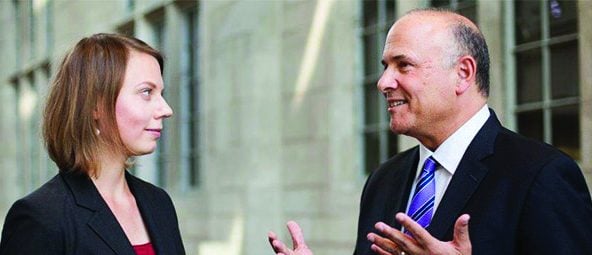Pritzker lawyers featured in second season of “Making a Murderer” talk Brendan Dassey appeals

Courtesy of Pritzker School of Law Center on Wrongful Convictions of Youth.
Laura Nirider and Steven Drizin. The two are heavily featured in the second season of “Making a Murderer” as the lawyers for Brendan Dassey.
November 1, 2018
A&E
Laura Nirider (School of Law ‘08) was a third-year law student intending to pursue a career in commercial litigation before she enrolled in Steven Drizin’s class on wrongful convictions in juvenile justice. Shortly after, the Pritzker School of Law professor was asked to handle the appeal of Brendan Dassey, a 16-year-old boy who — based on a single confession — was convicted of the murder and sexual assault of Wisconsin woman Teresa Halbach. Dassey would soon become a central figure in the Netflix docuseries “Making a Murderer.”
As one of Drizin’s students, Nirider was assigned to the Dassey case for her class, and was handed videotapes of the interrogation of Brendan Dassey, the same ones that would eventually be viewed worldwide.
“My heart broke,” Nirider said. “I couldn’t believe that this was a kid who was going to spend the rest of his life in prison based on (an interrogation that) was sort of obviously false and coerced. So pretty soon after, I found myself realizing that, yeah, this is what I wanted to do with my life.”
After a year in private practice, Nirider returned to Northwestern to help Drizin build the Center on Wrongful Convictions of Youth, a nonprofit legal clinic that aids children and teenagers just like Dassey. Working together as Dassey’s current lawyers, Nirider and Drizin are heavily featured throughout the second season of “Making a Murderer,” which premiered on Oct. 19.
The show’s second season focuses largely on the appeals processes of both Dassey and Steven Avery, Dassey’s uncle who was also convicted of the murder of Teresa Halbach. Avery previously had been wrongly convicted of sexual assault and served nearly twenty years in prison. He was in the process of suing Manitowoc County, Wisconsin, for this wrongful conviction and imprisonment when he was arrested again, this time on charges of murder.
Dassey’s appeal process is highlighted in season 2. After the case was appealed through the state level, Nirider and Drizin turned to the federal court system, filing a petition for habeas corpus. When a three-judge panel of the United States Court of Appeals for the Seventh Circuit ruled in favor of Dassey, the state of Wisconsin filed for a rehearing en banc, meaning the entire 7th circuit panel would be present. In December of 2017, the en banc panel upheld Dassey’s conviction, with the majority agreeing police had properly obtained Dassey’s confession.
In February of 2018, Dassey’s legal team filed for a writ of certiorari from the United States Supreme Court. This was denied in June of 2018.
The appeals process for Dassey’s case is not over though, Nirider said, citing a clemency petition from the governor of Wisconsin and a post-conviction petition as possible options on her Twitter. She said Dassey is now in a similar position to where Avery was at the end of the show’s first season.
Avery is now going through a post-conviction process himself with his new lawyer, renowned wrongful conviction attorney Kathleen Zellner. Nirider and Drizin said it is unclear if an acquittal for Avery would mean the same for Dassey, and said it would depend upon what grounds he would be acquitted on.
Drizin said he has watched the second season of “Making a Murderer” and is still generally positive about it, although he added it was “painful” to relive the experience already knowing the outcome. The reason they allowed the filmmakers so much access, he said, was to highlight the importance of the post-conviction process.
“It’s not something that people see a lot in documentaries or news shows,” Drizin said. “They might see when the DNA test comes back and points to somebody else, and then people walking out of prison into the arms of family and lawyers, but they don’t see the years of often difficult and challenging work before that moment happens.”
David Lakin (School of Law ‘17) worked alongside Drizin and Nirider on Dassey’s case as a student, mainly on the 7th circuit oral arguments. Lakin said he became involved in the case after watching the first season of “Making a Murder,” and was motivated to get involved with the Center on Wrongful Convictions of Youth.
Other than seeing himself on the show, Lakin said it was interesting to watch the second season because he got to view the reactions of Brendan Dassey’s family to the various appeals. Lakin also echoed Drizin’s sentiments, saying it was difficult to watch the process back already knowing the decision.
“There’s a few scenes where there’s reporters literally waiting outside the prison because they think Brendan’s going to be getting out,” Lakin said. “Then all of a sudden there’s this change of events and we couldn’t be farther from getting him out. The show depicts how close he is to being released multiple times, and to be so close and then be so far all of a sudden, it’s really tough to stomach.”
Nirider said she, Drizin and a social worker have been in contact with Brendan throughout the appeals process, and said he has been extremely grateful for the support he has received from fans of the show.
Although he was disappointed with the court’s decision, Nirider said Brendan still has hope for the future and a life outside of prison.
“Season 2 was released on Brendan’s 29th birthday, so he’s been in there for 13 years, but he’s still very much the person you see on those interrogation tapes,” Nirider said. “He is a resilient person. He’s patient, and he’s hopeful.”
Email: charlottewalsh2021@u.northwestern.edu
Twitter: @charwalsh_


